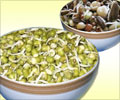Q: Which specialist doctor to consult for nutritional insufficiency?
A: A Nutritionist or a Dietitian can help with nutritional insufficiency.
Q: What are the healthiest microgreens?
A: The healthy list of microgreens includes mustard, radish, spinach, beet, wheat, sunflower, peas, alfalfa, carrot, flax, chia, broccoli, fenugreek, moringa microgreens, and manymore.
Q: How much microgreens should you eat a day?
A: One can include microgreens in the diet to meet nutritional requirements. Based on the individual’s requirement and diet, a nutritionist can help include microgreens in everyday diet.
Q: Can you eat microgreens raw?
A: Yes. Microgreens can be consumed raw for better nutrient availability.
Q: What is the best way to eat microgreens?
A: Microgreens are best consumed raw to gain nutritional benefits. It can be consumed as a salad or in wraps, soups, sandwiches, smoothies, or desserts.
Q: What is the shelf life of microgreens?
A: Microgreens should be stored at cold temperatures to maintain quality for over 14 days. At ambient temperature, the shelf life ranges between 3 and 5 days.






